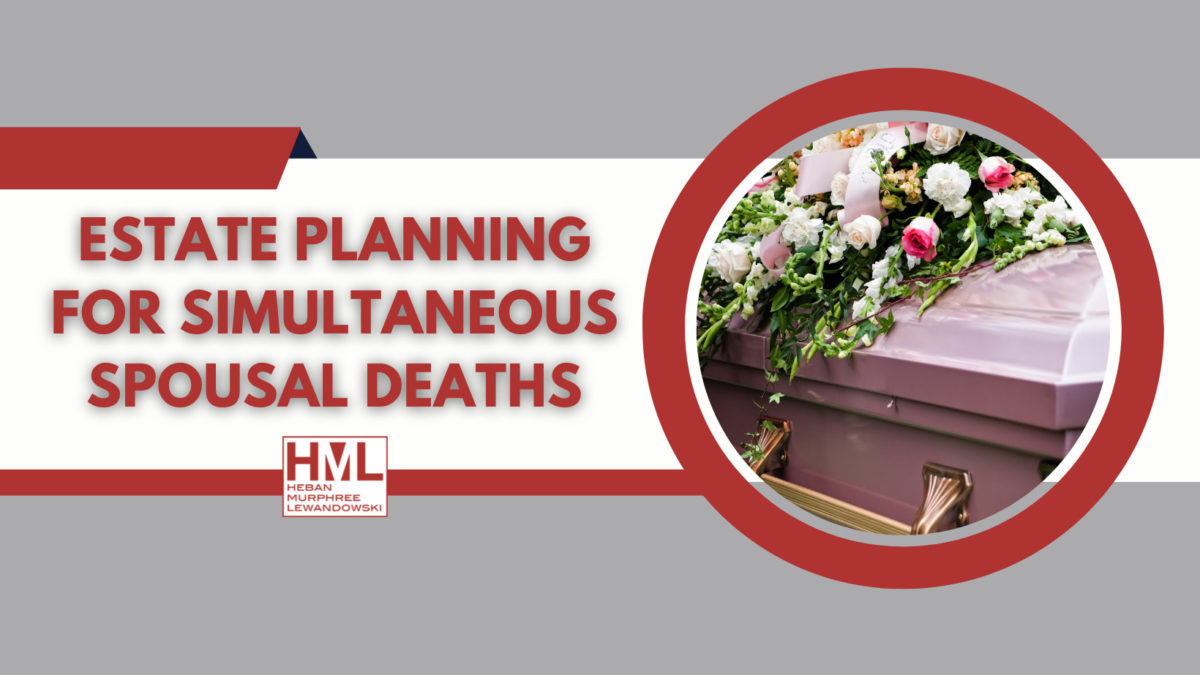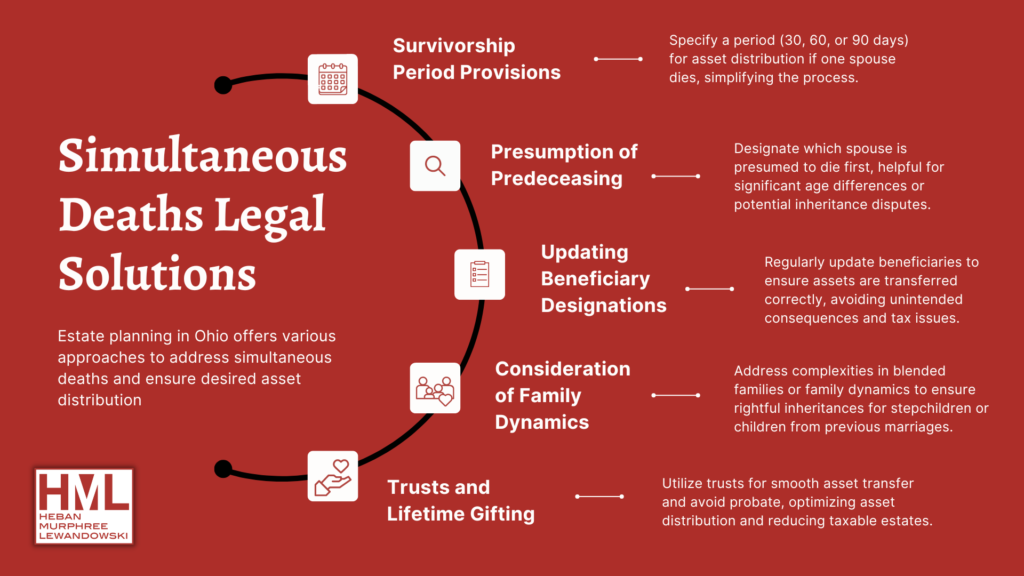- EXPERIENCED LAW FIRM IN TOLEDO, OH
- (419) 662-3100
What to Know When Both Spouses Pass Away Simultaneously

How Can Estate Litigation Be Avoided?
August 1, 2023
Guide to Ohio Family Business Succession
September 5, 2023Preparing for the Unexpected
Estate planning ensures loved ones are cared for, and assets are distributed as desired after passing away. Unforeseen circumstances may lead to simultaneous deaths in rare instances. As Ohio’s trusted advisors, we address these challenges, shedding light on legal implications, potential issues, and available solutions. Empowering you with the knowledge to safeguard your family’s future, let’s explore estate planning intricacies in the case of simultaneous deaths.
The Legal Implications of Simultaneous Deaths
The prospect of both spouses dying simultaneously or within a short period is an unsettling thought, yet it’s a situation that must be considered in estate planning. When such unforeseen circumstances occur, the legal implications can be complex and require careful attention.
Probate Complexity
One of the significant challenges arising from simultaneous deaths is the need for multiple probate cases. Probate is the legal process through which a deceased person’s assets are distributed, and debts settled. If both spouses’ estates must go through probate simultaneously, it can lead to additional costs, delays, and complications.
Consider a scenario where a married couple dies in a tragic car accident, with the husband passing away a few hours after the wife. Suppose all of the couple’s property titles are solely in the wife’s name, and both spouses named each other as the sole beneficiary, with their children as contingent beneficiaries in their respective wills. In such a case, unless there is a survivorship requirement in the wills, the law may necessitate separate probate cases for each spouse’s estate.
First, the wife’s will would direct the transfer of all property to the husband’s estate because he survived her by a few hours. Then, the husband’s will would require the transfer of all property to the children. This duplication of the probate process can be time-consuming, expensive, and fraught with legal complexities.
Estate Tax Implications
Another legal concern stemming from simultaneous deaths involves estate taxes. If both spouses have a substantial estate, their combined wealth may exceed the estate tax exemption amount. The current exemption is historically high, but it may change in the future, potentially leading to disagreements between the surviving family and the Internal Revenue Service over tax calculations.
Determining who died first becomes critical in such cases, as it affects the taxable amount. It can further complicate the estate tax calculation if it is impossible to ascertain who died first. For instance, if the husband died first and left everything to his wife according to his will, a significant portion of the estate may be subject to estate tax.
Seeking Solutions through Estate Planning
Fortunately, estate planning can provide solutions to these potential legal complexities. Many states, including Ohio, have adopted the Uniform Simultaneous Death Act (USDA) and other provisions to address simultaneous deaths.
To navigate these challenges effectively, couples can include simultaneous-death provisions in their estate planning documents. These provisions specify the survivorship requirements or designate which spouse should be presumed to have predeceased the other. This strategic estate planning can help ensure the couple’s assets are distributed according to their preferences and minimize tax implications.
Laws Addressing Simultaneous Deaths in Ohio
In Ohio, specific laws address these unique simultaneous death situations, offering guidance on how assets should be distributed in unfortunate circumstances. This includes:
The Uniform Simultaneous Death Act (USDA)
Ohio has adopted the Uniform Simultaneous Death Act, which provides a practical approach to resolving complications arising from simultaneous deaths.
- According to the USDA, if two individuals die within 120 hours of each other and the order of death cannot be determined, each is considered to have predeceased the other.
- This rule helps prevent estate disputes, simplifies inheritance processes, and avoids potential family conflicts when determining the order of death is impossible.
Customizing Estate Planning
While the USDA is a default rule, couples can tailor their estate planning to suit their preferences and circumstances.
- Estate planning documents can specify a longer survivorship period (e.g., 30, 60, or 90 days) before one spouse is considered to have predeceased the other.
- Couples may also designate which spouse should be presumed to have predeceased the other, addressing concerns about age differences or family disputes.
Accounting for Unique Assets
It’s essential to recognize that not all assets pass through the probate process. Assets held jointly with rights of survivorship, retirement accounts with designated beneficiaries, and life insurance policies pass directly to named beneficiaries upon death. Regularly reviewing and updating beneficiary designations ensures alignment with estate planning goals, avoiding unintended consequences and minimizing tax implications.
Potential Solutions for Simultaneous Deaths
Estate planning in Ohio requires careful consideration of the possibility of simultaneous deaths and how assets will be distributed in such unfortunate circumstances. Several key approaches can be employed to address this scenario and ensure that one’s estate plan reflects their wishes:
- Survivorship Period Provisions: Couples can include provisions in their estate planning documents specifying a survivorship period, such as 30, 60, or 90 days. This provision determines how assets will be distributed if one spouse passes away within the specified timeframe, simplifying the distribution process.
- Presumption of Predeceasing: Estate planning documents can designate which spouse should be presumed to have predeceased the other in the event of simultaneous deaths. This approach is particularly useful in cases with significant age differences between spouses or concerns about potential inheritance disputes.
- Reviewing and Updating Beneficiary Designations: Not all assets go through probate, as some pass directly to designated beneficiaries. Regularly reviewing and updating beneficiary designations is crucial to ensure that assets are transferred as intended, avoiding unintended consequences and minimizing tax implications.
- Consideration of Unique Family Dynamics: In cases of blended families or complex family dynamics, additional attention must be given to estate planning. Careful consideration ensures the rightful inheritance of stepchildren or children from previous marriages.
- Trusts and Lifetime Gifting: Utilizing trusts can effectively transfer assets and avoid probate, granting more control over asset distribution in the event of simultaneous deaths. Lifetime gifting can also help reduce taxable estates and optimize asset distribution.
Get Legal Help Now
Preparing for the unexpected is crucial in estate planning, even when facing the unlikely scenario of both spouses passing away simultaneously. At Heban, Murphree & Lewandowski, LLC, we understand the importance of addressing these challenges to protect your family’s future and assets.
Estate planning offers viable solutions to navigate legal implications and potential estate tax issues. Customizing your plan, reviewing beneficiary designations, and considering unique family dynamics are essential steps.
Our experienced team is here to guide you in creating a comprehensive estate plan that safeguards your loved ones and preserves your legacy for generations to come. Trust us to be your trusted advisors in estate planning, ensuring your wishes are honored even in unforeseen circumstances. Call now for a consultation. 419.662.3100









